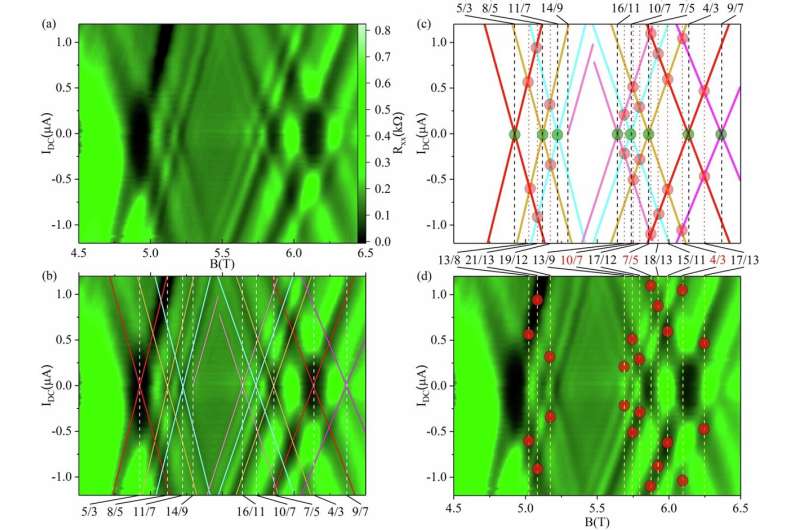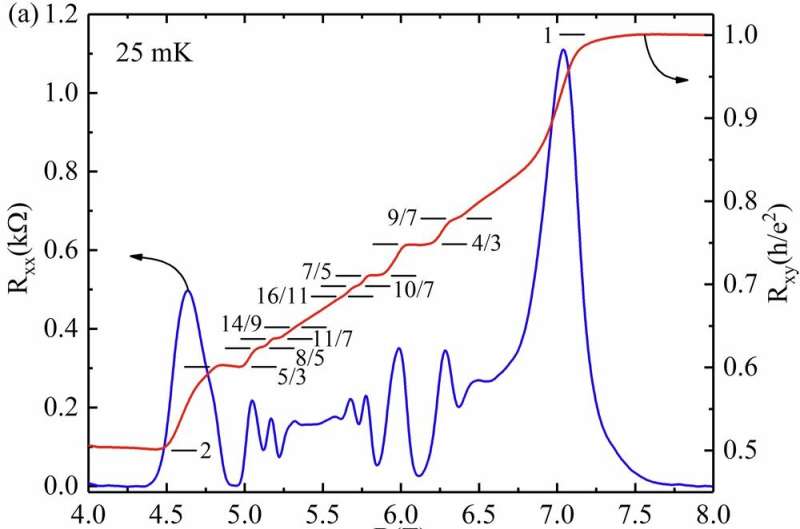This article has been reviewed according to Science X's editorial process and policies. Editors have highlighted the following attributes while ensuring the content's credibility:
fact-checked
peer-reviewed publication
trusted source
proofread
Physicists uncover new phenomena in fractional quantum Hall effects

Imagine a two-dimensional flatland, instead of our three-dimensional world, where the rules of physics are turned on their head and particles like electrons defy expectations to reveal new secrets. That's exactly what a team of researchers, including Georgia State University Professor of Physics Ramesh G. Mani and recent Ph.D. graduate U. Kushan Wijewardena, has been studying at Georgia State's laboratories.
Their studies have resulted in a discovery recently published in the journal Communications Physics. The team has investigated the enigmatic world of fractional quantum Hall effects (FQHE), uncovering novel, unexpected phenomena when these systems are probed in new ways and pushed beyond their usual boundaries.
"Research on fractional quantum Hall effects has been a major focus of modern condensed matter physics for decades because particles in flatland can have multiple personalities and can exhibit a context-dependent personality on demand," Mani said. "Our latest findings push the boundaries of this field, offering new insights into these complex systems."
The quantum Hall effect has been a vibrant and pivotal area in condensed matter physics since 1980, when Klaus von Klitzing reported his discovery that a simple electrical measurement could give very accurate values for some fundamental constants that determine the behavior of our universe. This discovery won him a Nobel Prize in 1985.
In 1998, a Nobel Prize was awarded for the discovery and understanding of the fractional quantum Hall effect, which suggested that flatland particles could have fractional charges. The journey continued with the discovery of graphene, a material that showed the possibility of massless electrons in flatland, leading to yet another Nobel Prize in 2010.
Finally, theories about new phases of matter, related to the quantum Hall effect, were recognized with a Nobel Prize in 2016.
Condensed matter physics gave rise to discoveries that made modern electronics like cellphones, computers, GPS, LED lighting, solar cells and even self-driving cars possible. Flatland science and flatland materials are now being studied in condensed matter physics with the aim of realizing more energy-efficient, flexible, faster and lighter-weight future electronics, including novel sensors, higher efficiency solar cells, quantum computers and topological quantum computers.

In a series of experiments in extremely cold conditions, close to -459°F (-273°C), and under a magnetic field nearly 100,000 times stronger than that of Earth, Mani, Wijewardena and colleagues went to work. They applied a supplementary current to high-mobility semiconductor devices made from a sandwich structure of gallium arsenide (GaAs) and aluminum gallium arsenide (AlGaAs) materials, which helps to realize electrons in a flatland.
They observed all the FQHE states splitting unexpectedly, followed by crossings of split branches, which allowed them to explore the new non-equilibrium states of these quantum systems and reveal entirely new states of matter.
The study highlights the crucial role of high-quality crystals, produced at the Swiss Federal Institute of Technology Zurich by Professor Werner Wegscheider and Dr. Christian Reichl, in the success of this research.
"Think of the traditional study of fractional quantum Hall effects as exploring the ground floor of a building," Mani said. "Our study is about looking for and discovering the upper floors—those exciting, unexplored levels—and finding out what they look like. Surprisingly, with a simple technique, we were able to access these upper floors and uncover complex signatures of the excited states."
Wijewardena, who earned his Ph.D. in physics from Georgia State last year and is now a faculty member at Georgia College and State University in Milledgeville, expressed his excitement about their work.
"We have been working on these phenomena for many years, but this is the first time we've reported these experimental findings on achieving excited states of fractional quantum Hall states induced by applying a direct current bias," Wijewardena said. "The results are fascinating, and it took quite a while for us to have a feasible explanation for our observations."
The study not only challenges existing theories but also suggests a hybrid origin for the observed non-equilibrium excited-state FQHEs. This innovative approach and the unexpected results highlight the potential for new discoveries in the field of condensed matter physics, inspiring future research and technological advancements.
The implications of the team's findings stretch far beyond the lab, hinting at potential insights for quantum computing and materials science. By exploring these uncharted territories, these researchers are laying the groundwork—and training new generations of students—for future technologies that could revolutionize everything from data processing to energy efficiency, while powering up the high-tech economy.
Mani, Wijewardena and their team are now extending their studies to even more extreme conditions, exploring new methods to measure challenging flatland parameters. As they push forward, they anticipate uncovering further nuances in these quantum systems, contributing valuable insights to the field. With each experiment, the team moves closer to understanding the complex behaviors at play, staying open to the possibility of new discoveries along the way.
More information: U. Kushan Wijewardena et al, Non-equilibrium excited-state fractionally quantized Hall effects observed via current bias spectroscopy, Communications Physics (2024). DOI: 10.1038/s42005-024-01759-7
Journal information: Communications Physics
Provided by Georgia State University





















